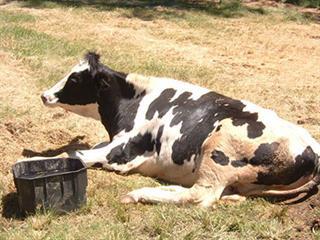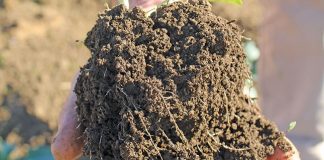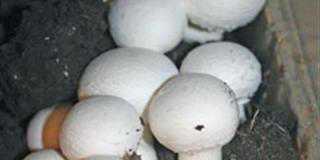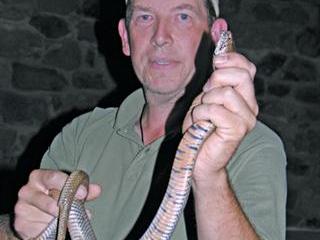
Bovine ephemeral fever or three-day stiff-sickness (TDS) is an insect-transmitted viral disease of cattle. It is one of the local dairy industry’s most important erosion diseases, and leads to annual losses of millions of rands. TDS starts suddenly and is normally of short duration. Most cases recover completely within three days, hence the name. Mortality in animals in good condition is usually low (less than 1%).
Sick animals suffer sudden onset of fever (40°C to 41°C), are stiff, lie down and are reluctant to rise or move around. The fever usually subsides and temperature returns to normal within 36 hours. Cows in an advanced stage of pregnancy may abort. A dramatic decline in the milk production of dairy cows and the quality thereof can cause great economic losses. The fertility of affected bulls is temporarily suppressed. Sheep and goats are not affected by TDS.
Cause of TDS
TDS is caused by a virus transmitted to cattle by biting insects. Midges (Culicoides spp.) and mosquitoes (Culex spp. and Anopheles spp.) are the main vectors. Other insect species are also suspected, but to date have not been identified. Bovine tissue (meat) and body fluid (such as nasal discharge) do not play a role in virus transmission in cattle. Should an animal infected with TDS die, lactic acid forming in bovine tissue (muscle) soon neutralises the virus.
Occurrence
TDS is seasonal and occurs regularly in all South African provinces, especially in late summer and autumn (March to May), with isolated cases recorded in winter. Outbreaks usually occur at times of above-average rainfall. When rainfall is below average, the disease occurs sporadically and wanes after the first frost. In Israel, TDS has been recorded as ceasing when the average night temperature drops to below 16°C.
How and where the virus overwinters has not yet been fully researched. When an animal contracts TDS, it usually develops a life-long immunity. The presumption that more than one virus strain causes TDS is still to be proven. Disease antibodies have been found in buffalo, blue wildebeest, waterbuck and hartebeest. Whether these species play a role in the overwintering of the virus is unknown.
Virus to disease
The virus leads to infection and damage, especially to the minor blood vessels of the tendons, muscles, joints and skin. The level of potassium, iron and zinc declines markedly. The ‘paralysis’ of animals contracting TDS is similar to that of dairy cows with milk fever (hypocalcaemia). Milk fever is coupled with a reduction in the calcium level in the blood. Some animals become permanently paralysed from TDS.
The cause of spinal cord degeneration that leads to paralysis is still uncertain. It would appear that purebred cattle breeds (such as Holstein and Brahman) are more susceptible to TDS than crossbred cattle.
Symptoms
The disease occurs in mild, moderate and serious degrees. The fertility of a cow is seldom affected. Lactating cows generally exhibit more serious visible symptoms than do dry cows. Cattle recovering from TDS have usually developed an immunity and seldom contract the disease a second time.
Mild
The affected animal is lethargic, stiff, has a fever for a short period, is reluctant to move and may stop eating and drinking. Milk production in dairy cows drops dramatically – between 10% and 95% – for a few days, or may cease altogether. The animal’s condition may deteriorate dramatically. Sometimes, subclinical mastitis develops, the somatic cell count of the milk increases abnormally and the quality of the milk decreases. Affected cows usually recover two to three days after the fever lapses and body temperature returns to normal.
Recovery is normally complete after three days or so, although serious cases may persist for weeks. Most affected cows never return to their original milk production level, but they do recover completely from weakness and lameness.
Moderate
Sick animals leave the herd, stop eating, are stiff, exhibit muscular tremors and develop a lameness that shifts from leg to leg. Eye and nasal discharge, excessive salivation and swollen joints also occur. In some cases, a subcutaneous oedema of the lower jaw is prominent. Bulls can become temporarily infertile, producing abnormal sperm for between three and six months. Permanent infertility in bulls occurs rarely. The disease is usually less serious in calves younger than 12 months.
Serious
The animal lies on its sternum and cannot rise. Degeneration of the spinal cord leads to permanent paralysis. An animal lying down for a long period can develop pressure sores and may contract pneumonia. It cannot swallow, becomes bloated, its rumen activity ceases (rumenstasis) and it becomes constipated. It salivates excessively and often rests its head on its flank.
It continually changes between lying normally on its stomach with its head up, and on its side. Reflex action ceases, the animal falls into a coma and finally dies. In some cases, the lungs are affected. Gurgling sounds are audible and pneumonia may develop. A small percentage of cases develop lung emphysema with subcutaneous emphysema (accumulation of air) in the back and other parts of the body. Such cases are referred to as atypical TDS.
Diagnosis
A vet bases the provisional diagnosis on the sick animal’s disease symptoms, season of the year and other relevant information. Blood samples can be taken when the animal is sick as well as after recovery to show antibodies. The blood profile of a sick animal will show an increase in white blood cells. Diagnosis is confirmed by examining the effect of the virus on body tissue, as seen under an electron microscope.
Conditions often confused with TSD
There are a number of disease conditions with symptoms similar to TDS:
- Milk fever;
- Botulism (caused by Clostridium botulinum);
- Neurotoxicosis (caused by eating maize infected with the fungus Diplodia maydis);
- Physical injuries;
- Eating toxic plants (Crotalaria spp.) that causes laminitis and outgrown hooves;
- Various lung disorders and conditions, which must be distinguished from lung emphysema due to TDS.
Treatment
- Consult a vet;
- Ensure sufficient rest for recovery;
- Protect the animal from heat stress, wind and cold;
- Provide sufficient clean, fresh water as well as palatable and nutritious feed;
- Rehydrate dehydrated animals by administering water and electrolytes;
- Administer anti-inflammatory medication (steroids and non-steroids) to counteract inflammation;
- Administer calcium, zinc and iron;
- Do not administer liquid by mouth if the swallowing reflex is absent;
- Administer medication to stimulate the rumen and counteract constipation.
Prevention and control
- Vaccination: Vaccinate cattle for the first time at six months or older, with a follow-up four weeks later. Adult cows can be vaccinated irrespective of the stage of pregnancy or lactation. Annual revaccination is recommended. If possible, vaccinate animals late in winter or early in spring. TDS vaccine (freeze-dried, living, weakened virus) may be administered with any other bacterial or dead vaccine if necessary.Calves of vaccinated cows that had previously contracted TDS are protected by the dam’s colostrum up to the age of six months.
- Spraying: Spray cattle regularly with insect repellent to protect them from being bitten by midges and mosquitoes. If possible, avoid grazing or overnighting cattle in low-lying, well-watered areas or alongside dams, vleis or pans. Preferably, graze them on upland areas.
- Exposure: Young dairy heifers (six month to 14 months) can be exposed to natural TDS infection after TDS vaccination before coming into lactation by allowing them to graze in low-lying, well-watered areas.Dairy cattle should ideally have TDS immunity before coming into milk production. Consult a vet before embarking on this practice, however.
Email Dr Jan du Preez, managing director of the Institute for Dairy Technology, at [email protected], or Dr Faffa Malan, manager of the Ruminant Veterinary Association of SA, at [email protected].













